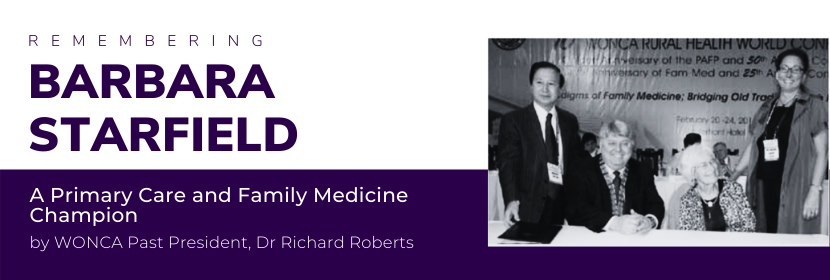A Primary Care and Family Medicine Champion

The telephone rang loudly, propelling me out of bed. The bedside clock glowed 01:00. Like a triple jumper, I hopped over the cushions scattered across the Orlando hotel room floor on which slept our four young children. I grabbed the desktop phone and growled, “Hello?!” The voice at the other end replied, “Hello. Dr Roberts? This is Barbara Starfield. Congratulations on becoming the next President of the American Academy of Family Physicians. If you have a few moments, I’d like to share with you what family doctors need to do better.”
I was tempted to tell her that it was too late to talk. (I was in Florida; she was in California where it was ten in the evening). My next thought was to ask who was she to tell me what was wrong with family doctors. I knew that she had trained as a pediatrician, worked as a health services researcher, and taught at Johns Hopkins, which had no department of Family Medicine at its medical school. What could she know about family doctors?
Fortunately, I was awake enough to know it was best to suppress those initial thoughts. Instead, I kept quiet and listened. It was one of the better decisions of my professional life. That first conversation led to a cherished mentor-like relationship with Barbara that continued until her death 12 years later.
What was it that Barbara said that night? She expressed concern about decreases in continuity of care and scope of practice among family doctors. Her studies of healthcare systems around the world convinced her that the best systems are built on a solid foundation of primary care. Furthermore, it was family doctors who made for the best primary care systems. What made family doctors so important, she told me many times, was their continuity relationships with, and broad range of services provided to, the patients under their care.
She believed that continuity relationships with patients promote trust and better appreciation for each person’s unique life story, making for more patient-centered care. More comprehensive services increase the chance that people will actually get the most appropriate services they need, with less risk of under- or over-utilization. Continuity offers more opportunities to provide more comprehensive care, which in turn increases trust and strengthens the relationship – a virtuous circle results.
Barbara was always busy with more studies to conduct, publications to write, students to teach, and policymakers to persuade. Even into her late seventies, she traveled constantly around the globe.

It was my sad duty in June 2011 to report
the news of Barbara’s death to the WONCA global community (1). Ironically, even her death served as a reminder of the hazards of care that is not truly patient-centered, as her husband
Tony eloquently wrote (2).
Primary care and Family Medicine had no better champion and friend. I miss her.
Dr Richard Roberts,
WONCA Past President
1. New release on the death of Barbara Starfield to WONCA members by President Richard Roberts
2. Holtzman, NA. Chronicle of an Unforetold Death. Archives of Internal Medicine 2012;172(15):1144-1147. Published online July 9, 2012.
Return to Main Page